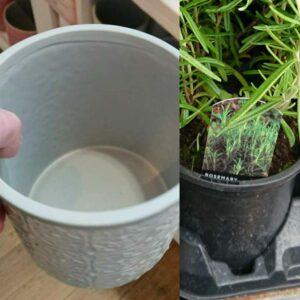Rosemary, a versatile herb that flourishes in pots, may appear to be drying out due to excess moisture around the roots. In this article, we will explore the causes of potted rosemary drying out and provide practical tips to ensure your plant thrives.
Causes of Potted Rosemary Drying Out
Rosemary originates from the Mediterranean, where it thrives in sandy, well-draining soils and infrequent rainfall. To replicate these optimal growing conditions, it is crucial to allow the soil around the roots to dry out somewhat between waterings.
If the soil remains persistently damp, your rosemary may be at risk of developing root rot or fungal diseases like ‘Botrytis.’ Look out for the following symptoms:
- A dried out appearance
- Leaves and stems turning brown
- An overall drooping appearance
Surprisingly, overwatering is often the culprit behind a seemingly dried out potted rosemary. Although the plant requires regular watering, it prefers well-draining soil that doesn’t retain excess water. However, other factors can contribute to excessive moisture around the roots, such as:
- Planting rosemary in moisture-retaining soil without incorporating sand or grit to improve drainage
- Using pots without drainage holes or relying on drip trays that collect excess water
Misinterpreting a drying out rosemary as a sign of thirst, many gardeners increase watering, exacerbating the root rot problem. Keep in mind that, once established, rosemary is drought-resistant and rarely suffers from a lack of water. However, if you observe a drooping appearance, it may indicate a dehydrated plant that will respond well to watering.
Pots Without Drainage and Drip Trays
One of the most common reasons for excessively damp soil is planting rosemary in a pot without drainage holes or using drip trays to collect water. Rosemary roots prefer somewhat dry soil between waterings, so decorative pots without proper drainage can lead to saturated soil and root rot.
If you’re growing rosemary indoors and using a drip tray, it creates the same problem as a pot without drainage. Even a small amount of water in the tray prevents the soil from drying out properly, increasing the risk of root rot and fungal diseases. To prevent this, follow these tips:
- Always plant rosemary in a pot with drainage holes. If necessary, drill holes yourself.
- Avoid using drip trays. Instead, place a paper towel under the pot after watering for a few hours to allow excess water to drain without damaging furniture.
Overwatering Rosemary in Pots
With its Mediterranean heritage, rosemary is drought-resistant when established and typically requires watering once every two weeks, or perhaps once a week in hot weather. Consistently damp soil due to frequent watering (in pots or garden soil) can lead to root rot or fungal diseases, resulting in a seemingly dried out appearance.
Pots generally provide favorable drainage conditions that mimic the hillsides where rosemary thrives in Southern France. However, it’s crucial to choose a pot that is approximately 12-16 inches across. Smaller pots heat up quickly in the blazing sunshine, causing rapid soil drying and preventing effective water uptake by the roots.
The only time rosemary tends to suffer from under-watering is if the pot is too small or made from heat-conductive materials like metal or plastic. Drooping new growth may indicate a lack of water, but this is more common in small pots or neglected houseplants, rather than outdoor potted rosemary.
Use a Well-Draining Potting Mix for Rosemary
To prevent your rosemary from succumbing to fungal diseases and developing a dried up and brittle appearance, it’s crucial to provide it with optimal soil conditions. Rosemary can grow in a wide range of soils, but it thrives in sandy or stony soils with low to medium nutrient levels and excellent drainage.
While pots already provide some drainage, it’s essential to replicate the sandy soil conditions. Add horticultural sand, grit, or perlite to the potting mix to ensure proper drainage and prevent excessive moisture retention. Aim to incorporate roughly 20% sand or grit to 80% potting soil or compost. Use a regular multipurpose compost without moisture-retaining agents or added fertilizer, as this contradicts the preferred soil conditions.
The addition of sand or grit creates a porous texture that allows for quick soil drainage while enabling root establishment and respiration. With a well-draining potting mix, the roots can remain dry between waterings, reducing the risk of root rot and the resultant dried out appearance.
Key Takeaways:
- A seemingly dried out potted rosemary is usually a sign of overwatering rather than under-watering.
- The dried out appearance is actually a symptom of root rot or fungal diseases that thrive in damp soils.
- Rosemary prefers dry soil between waterings, so ensure your pot has good drainage. Amend the soil with sand or grit and water only once every two weeks to prevent root rot and fungal diseases, which cause the drying out appearance.
Now armed with this knowledge, you can provide your potted rosemary with the ideal growing conditions, ensuring its health and vitality. Happy gardening!



